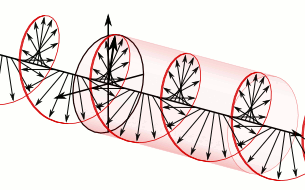

Certain types of jewel scarab beetles utilize circularly polarized light (CP light) to both hide from predators and to find each other. In particular, Chrysina gloriosa beetles (above left) are camouflaged among the juniper bushes they prefer, unless viewed with circularly polarizing filters.
As shown in the diagram on the top right, CP light travels in a circular pattern. It is commonly used to create 3D movie affects. Because humans can’t perceive CP, we have to wear special glasses during 3D movies. In fact, only one other creature is known to be able to see CP light, and that’s the mantis shrimp.
Parrish Brady and Molly Cummings of The University of Texas, Austin, confirmed that Chrysina gloriosa can detect CP light by observing the insects’ responses to various light cues. They contrasted the behavior of C. gloriosa with that of the closely related C. woodi (beetles that do not have CP reflecting carapaces). Perhaps not surprisingly, the C. woodi beetles could not detect CP light.
The researchers speculate that C. gloriosa use CP light not only to hide from predators (which most likely can not see that type of light) and to find each other, but also to communicate with each other. They are conducting further tests to see exactly how this might work.
No comments:
Post a Comment